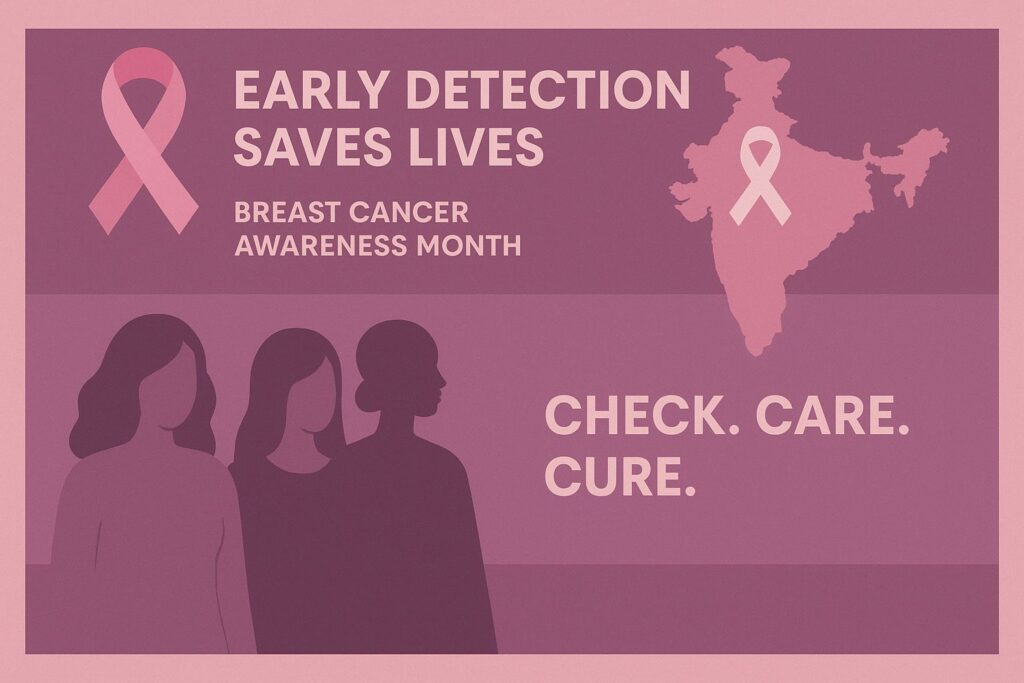Rising Burden in India
Breast cancer is the most common cancer among women in India, with nearly 2,43,905 new cases and close to 1,02,377 deaths reported in 2024. Over the past three decades, the incidence has steadily risen, particularly in urban and semi-urban populations. States like Kerala, Tamil Nadu, Telangana, and Karnataka consistently report higher incidence compared to other regions.
Younger Age of Onset
Unlike many Western countries where breast cancer peaks in women aged 60 and above, Indian women are often diagnosed much earlier. A significant proportion of cases occur in women in their 30s and 40s. This younger age at diagnosis makes the disease more socially and economically impactful, often affecting women during their most productive years.
Challenges of Late Diagnosis
More than half of Indian women with breast cancer are diagnosed at advanced stages. This delay is largely due to low awareness, lack of screening programs, and cultural stigma. As a result, survival outcomes are significantly lower than those in high-income countries. The overall five-year survival in India remains around 66%, compared to over 85% in many Western nations.
Symptoms and Warning Signs
Early breast cancer may be silent, but common warning signs include:
- A painless lump or thickening in the breast or underarm
- Changes in breast size or shape
- Skin dimpling, puckering, redness, or thickening
- Nipple inversion or unusual discharge
- Persistent breast pain or discomfort
Recognizing these signs and seeking early medical advice is crucial for timely treatment.
Self-Examination and Screening
Breast self-examination (BSE) is an important awareness tool. Women are advised to perform it once a month, ideally a few days after menstruation or on a fixed date post-menopause. Self-examination includes both visual inspection for changes in shape, skin, or nipple, and palpation to detect lumps.
Screening methods include:
- Mammography: the gold standard for women above 40 or earlier in high-risk groups.
- Ultrasound: particularly useful in younger women with dense breast tissue.
- MRI: reserved for women with genetic risk or equivocal imaging findings.
Unfortunately, mammography uptake in India remains low due to limited access and lack of structured national screening programs.
Diagnosis and Subtypes
Diagnosis requires a combination of clinical examination, imaging, and biopsy. Determining the molecular subtype is essential to guide therapy. In India, triple-negative breast cancer (TNBC), an aggressive form with fewer treatment options, accounts for nearly one-third of cases – higher than in Western populations. Hormone-receptor positive (luminal) and HER2-positive cancers also form significant proportions, each requiring targeted treatment approaches.
Treatment Approaches
Treatment in India is multidisciplinary and depends on the stage and subtype:
- Surgery: breast-conserving surgery or mastectomy
- Radiotherapy: often given after breast-conserving surgery or in high-risk cases post-mastectomy
- Chemotherapy: used as neoadjuvant or adjuvant treatment
- Hormonal therapy: for hormone receptor-positive cancers
- Targeted therapy: such as trastuzumab for HER2-positive tumors
- Immunotherapy: increasingly used in triple-negative breast cancer
Supportive care, including psychological support, rehabilitation, and survivorship planning, is equally vital.
The Way Forward
Addressing breast cancer in India requires a multi-level approach:
- Improve awareness and encourage self-examination
- Strengthen access to mammography and diagnostic facilities
- Promote early referral to Oncology centres
- Ensure equitable access to modern therapies
- Invest in cancer registries to better understand patterns and outcomes
Conclusion
Breast cancer is no longer a rare disease in India – it is a public health priority. With earlier detection, greater awareness, and improved access to multidisciplinary treatment, survival outcomes can be transformed. This October, during Breast Cancer Awareness Month, the message is clear: Early detection saves lives.
References
- Cancer Incidence and Mortality Across 43 Cancer Registries in India https://jamanetwork.com/journals/jamanetworkopen/fullarticle/2837792
- Nandakumar A et al. “The increasing burden of breast cancer in India.” Cancer Epidemiology. 2022. PMC Link
- Burden of female breast cancer in India: estimates of DALYs. BMC Women’s Health. 2024. PMC Link
- Mutebi M et al. “Breast Cancer Care in India: Challenges and Opportunities.” JCO Global Oncology. 2020. ASCO Link
- Survival outcomes and stage at diagnosis in Indian women. Frontiers in Public Health. 2025. Frontiers Link
Prevalence of molecular subtypes in Indian women. Indian J Med Res. 2021. PMC Link


